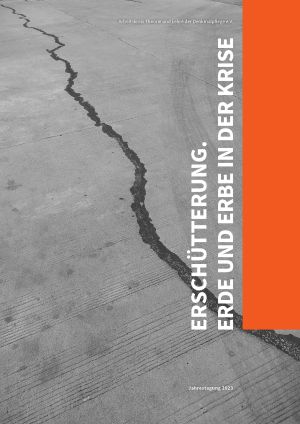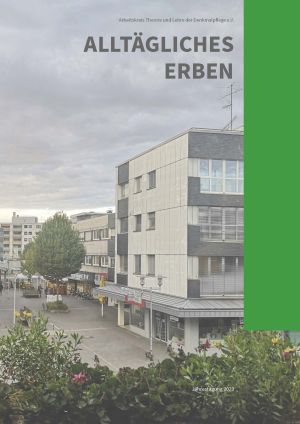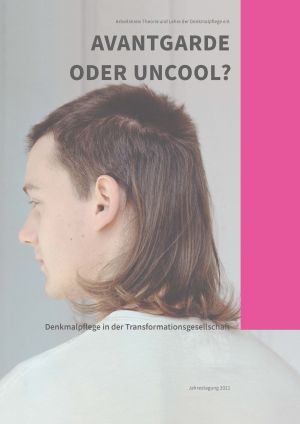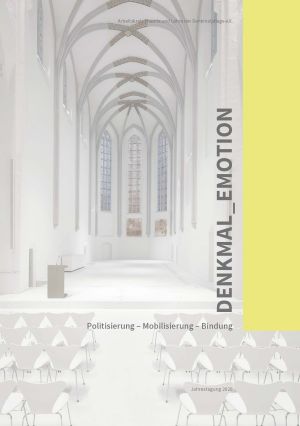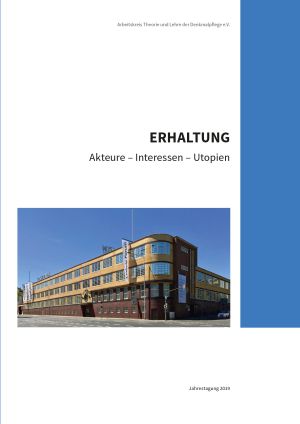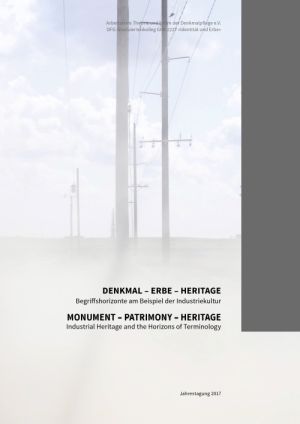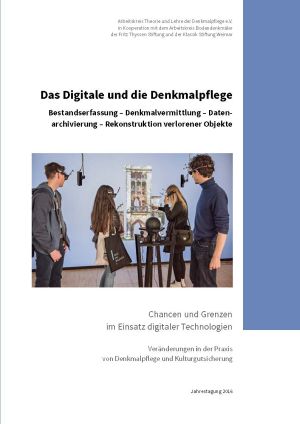Veröffentlichungen des Arbeitskreises Theorie und Lehre der Denkmalpflege e.V.
The Working Group is an association of academics and other professionals active in the field of heritage conservation at universities and colleges of applied sciences in Europe. In keeping with the interdisciplinary character of conservation work, the Group brings together representatives of a range of different areas, including architecture and building archaeology, history and art history, restoration sciences, landscape architecture, construction engineering, jurisprudence and urban planning, among others.
The Working Group’s nearly 140 members are drawn primarily from the German-speaking countries – in addition to Germany, also Austria, Switzerland and Luxemburg – but also from Italy, Belgium, the Netherlands, England, Slovakia, Croatia and Romania. Since the 1970s it has been dedicated to the exchange of ideas and experience on the theory and teaching of heritage conservation among colleagues at institutions of higher education. The Group sees itself as representing the interests of heritage professionals and as such is a member of the German National Committee for Monuments Protection (DNK).
Contact
Arbeitskreis Theorie und Lehre der Denkmalpflege (AKTLD)
Prof. Dr. Christian Raabe (1. Vorsitzender)
RWTH Aachen
Fakultät Architektur
Lehr- und Forschungsgebiet Denkmalpflege und Historische Bauforschung
Schinkelstraße 1
52062 Aachen
E-Mail: AKTLD@dhb.rwth-aachen.de
Internet: Arbeitskreis Theorie und Lehre der Denkmalpflege e.V.
Published so far
Erschütterung. Erde und Erbe in der Krise: Tremor. Earth and Heritage in Crisis
Erschütterung (tremor) discusses the destruction and damage to architectural monuments caused by physical crises such as earthquakes, floods or war, as well as the emotional, social and societal shocks that arise in this context. The subtitle Earth and Heritage in Crisis refers to the close links between global disasters, heritage making and preservation. The conference volume therefore deals with fundamental questions about how heritage preservation deals with such crises and their consequences. In addition to topics of conservation and restoration, strategies of reconstruction and remembrance, it is asked how the discipline of heritage preservation itself has been shaped by crises. Interdisciplinary case studies will be used to discuss the limits, possibilities and conflicts of heritage preservation caused by war and trauma.
Alltägliches Erben
When considering historical cities, monuments and architectural heritage, a large part of the building stock is left out – marginalized as too ordinary or mundane. It often seems as if only “the highlights" make it into the art historical and preservationist canon. The conference volume ALLTÄGLICHES ERBEN therefore deals with fundamental questions about the perception, appreciation and value of “everyday architecture”. In different perspectives, international, historical, and theoretical backgrounds of the everyday are illuminated, building tasks and challenges of monument preservation are discussed.
Avantgarde oder uncool? Denkmalpflege in der Transformationsgesellschaft
Under the deliberately provocative title "Avantgarde or uncool?", this volume examines traditions of how heritage preservation is perceived by itself and by others. The background to this critical review is the question of the necessity of repositioning the profession - not only in view of the current challenges of climate change, but also the increasing political and social need for participation. The volume thus brings together not only reflections on the profession's self-image in times of change, but also on professional positions in relation to current issues such as participation, climate change and diversity.
Denkmal_Emotion: Politisierung – Mobilisierung – Bindung
The "emotional turn", it seems, has meanwhile arrived in the field of Heritage Studies. The connection between emotions and heritage/monuments can be regarded as a reciprocal and interdependent relationship. Understood as an integral part of processes of individual and collective meaning-making, emotions are being reconceived as a formative aspect of valorization, appropriation and rejection rather than their mere by-product, and as such are being recognized as constitutive for the field of heritage conservation. The essays gathered here reflect in their range the different facets of the complex relationship between Heritage Studies and emotions, be it in relation to the political dimensions of that relationship, to the development of new emotional points of reference or to very concrete processes of the appropriation or rejection of heritage.
Erhaltung: Akteure – Interessen – Utopien
The will to preserve the architectural cultural heritage can be considered one of the cornerstones of heritage conservation theory and practice. In addition to this seemingly common, overarching goal, however, a closer look reveals a broad spectrum of different objectives and priorities. These are each closely linked to the social contexts and the people involved. For what is understood by preservation and what is to be preserved in a monument is to a large extent related to what is considered to constitute its value - and is thus dependent not only on the constantly changing technical prerequisites, but also on personal and social attributions of value.
Renationalisierung oder Sharing Heritage? Wo steht die Denkmalpflege im Euopäischen Kulturerbejahr 2018?
„Überall in Europa erleben wir gegenwärtig deutliche Renationalisierungsbewegungen und eine Inanspruchnahme des kulturellen Erbes für Identitätsbildungsprozesse von Ländern und Regionen. Im Zuge dessen werden die Grenzen zu Anderen deutlicher als zuvor markiert und Fragen der Zugehörigkeit zum Erbe kritisch ventiliert (z.B. gehört der Islam zu Deutschland/Europa? müssen wir Grenzkontrollen reaktivieren? etc.). Diesem Trend suchen europäische Institutionen durch die Betonung gemeinsamer Werte und Traditionen entgegenzusteuern – nach der Deklaration von Faro 2005 gilt das nicht zuletzt für die Ausrufung des europäischen Kulturerbejahres, das 2018 unter dem Motto Sharing Heritage steht und zu einer Neu-Betrachtung des kulturellen Erbes unter Prämissen des Kulturtransfers und der Rezeption von Ideen auffordert. Grenzräume erfahren dabei als Austauschregionen, aber auch als potentielle Konfliktregionen eine besondere Beachtung. Denkmalpflege, Archäologie und Museologie sind durch die aktuellen Neubewertungen des kulturellen Erbes wie alle anderen sammelnden Fächer zu einer Positionsbestimmung herausgefordert.“
Ingrid Scheurmann
Denkmal – Erbe – Heritage: Begriffshorizonte am Beispiel der Industriekultur
This Volume offers two languages (german/english)
If “Sharing Heritage” is to be taken seriously, then it must have consequences for the assessment of value – in Europe, but also beyond: in place of the more exclusionary “World Heritage”, which tends to foreground each country's own, often nationally-defined achievements and merits, we should strive toward the creation of a “Global Heritage,” one capable of building bridges on the basis of universal values, thereby bringing the world’s people closer together as a global community with a common destiny.
The 2017 Annual Meeting of the Working Group on Theory and Education in Heritage Conservation on the topic “Monument – Patrimony – Heritage” at the TU Berlin was at the same time the first Annual Meeting of the Research Training Group 2227 “Identity and Heritage” (GRK 2227), funded by the DFG. A cooperation between the two was particularly opportune, as the Working Group had decided on Berlin as the location of the annual meeting and, in view of the motto “Sharing Heritage” of the European Cultural Heritage Year 2018, to dedicate it to a discussion of monument and heritage terminology, while the Research Training Group, with seats in Berlin and Weimar, had been launched to address such questions and a number of colleagues are active in both bodies.
Das Digitale und die Denkmalpflege: Bestandserfassung – Denkmalvermittlung – Datenarchivierung – Rekonstruktion verlorener Objekte
The ‘digital revolution’ is now in full swing. For heritage conservation, digital tools have opened new perspectives, finding application in the interactive visualization of past situations, the monitoring of threatened sites and artefacts, or the complex cross-referencing of heterogeneous collections of knowledge. At the same time, the limits and unsolved problems associated with using digital technologies are also becoming more apparent, for example with regard to maintaining the rapidly-growing volumes of data being generated.
And yet with digitization, we are not dealing primarily with a ‘technical’ innovation. Thus the effort to conserve digital heritage, including documenting, researching and publishing cultural assets, will transform more than just the institution of the museum. The new abundance of digitally-generated images can also be seen to be changing the standards of the scientific and academic discipline. A further and as yet underappreciated aspect of the digital revolution is the way it is rearranging the foci of attention in the knowledge ‘market’.
Perhaps the most noticeable consequence of digitization’s promise of exact and comprehensive reproduction is the knee-jerk insistence, following every instance of the spectacular destruction of a famous monument, on creating a reconstruction. Here it is clear that an affinity for reconstruction is inherent in the digital, to the extent that its primary feature is its capacity to translate all information into binary code, to capture and copy exactly, supposedly without loss of detail. In the digital age, the distinction between original and copy will therefore lose relevance – at the cost of a total manipulability of data, and of reality.



